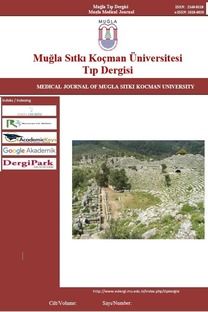Sağlıklı Bireylerde ve Kognitif Etkilenmesi Olanlarda Kokusal ve Görsel Elektrofizyolojik İncelemelerin Tanıya Katkısı ve Nöropsikolojik Test Sonuçlarıyla İlişkisi
Kognitif Etkilenme, Koku Tanıma, Olaya İlişkin Potansiyeller
The Contribution of Olfactive and Visual Electrophysiological Tests to Diagnosis in Healthy and Cognitively Affected Individuals and its Relation to Nerophyschological Test Results
___
- 1. Petersen RC, Stevens J, Ganguli M, Tangalos EG, Cummings JL, DeKosky ST. Practice parameter: early detection of dementia: mild cognitive impairment (an evidence-based review). Report of the Quality Standards Subcommittee of the American Academy of Neurology. Neurology. 2001;56(9):1133-42.
- 2. Petersen RC. Mild cognitive impairment as a diagnostic entity. J Int Med. 2004;256(3):183-94.
- 3. Braak H, Braak E. Frequency of stages of Alzheimer-related lesions in different age categories. Neurobiol Aging. 1997;18(4):351-57.
- 4. Hyman BT. The neuropathological diagnosis of Alzheimer’s disease: clinical-pathological studies. Neurobiol Aging. 1997;8(4 Suppl):27-32.
- 5. Koss E, Weiffenbach JM, Haxby JV, Friedland RP. Olfactory detection and recognition in Alzheimer’s disease. Lancet. 1987;1(8533):622.
- 6. Djordjevic J, Jones-Gotman M, De Sousa K, Chertkow H. Olfaction in patients with mild cognitive impairment and Alzheimer's disease. Neurobiol Aging. 2008;29(5):693-706.
- 7. Jeong J. EEG Dynamics in patients with Alzheimer’s disease. Clin Neurophysiol. 2004;115(7):1490-505.
- 8. Brodie EE, Allan D, Brooks DN, McCulloch J, Foulds WS. Flash and pattern reversal visual evoked responses in normal and demented elderly. Cortex. 1992;28(2):289-93.
- 9. Polich J, Ehlers CL, Otis S, Mandell AJ, Bloom FE. P300 latency reflects the degree of cognitive decline in dementing illness. Electroencephalogr Clin Neurophysiol. 1986;63(2):138-44.
- 10. Serby M, Corwin J, Novatt A, Conrad P, Rotrosen J. Olfaction in dementia. J Neurol Neurosurg Psychiatry. 1985;48(8):848-49.
- 11. Murphy C, Bacon AW, Bondi MW, Salmon DP. Apolipoprotein E status is associated with odor identification deficits in “normal” older persons. Ann NY Acad Sci. 1998;855:744-50.
- 12. Nordin S, Murphy C. Impaired sensory and cognitive olfactory function in questionable Alzheimer’s disease. Neuropsychology. 1996;10(1):113-19.
- 13. Campanella S, Rossignol M, Mejias S, Joassin, F, Maurage P. Human gender differences in an emotional visual oddball task: an event-related potentials study. Neurosci Lett. 2004;367(1):14-18.
- 14. Bacon AW, Bondi MW, Salmon DP, Murphy C. Very early changes in olfactory functioning due to Alzheimer’s disease and the role of Apolipoprotein E in olfaction. Ann NY Acad Sci. 1998;855:723-31.
- 15. Schiffman SS, Graham BG, Sattely-Miller EA, Zervakis J, Welsh-Bojmer K. Taste, smell and neuropsychological performance of individuals at risk for Alzheimer’s disease. Neurobiol Aging. 2002;23(3):397-404.
- 16. Knott V, Mohr E, Mahoney C, Ilivitsky V. Quantitative electroencephalography in Alzheimer's disease: comparison with a control group, population norms and mental status. J Psychiatry Neurosci. 2001;26(2):106-16.
- 17. Kawas CH, Corrada MM, Brookmeyer R, et al. Visual memory predicts Alzheimer's disease more than a decade before diagnosis. Neurology. 2003;60(7):1089-93.
- 18. Kergoat H, Kergoat MJ, JustinoL, Chertkow H, Robillard A, Bergman H. Visual retinocortical function in dementia of the Alzheimer type. Gerontology. 2002;48(4):197-203.
- 19. Philpot MP, Amin D, Levy R. Visual evoked potentials in Alzheimer's disease: correlations with age and severity. Electroencephalogr Clin Neurophysiol. 1990;77(5):323-29.
- 20. Martinelli V, Locatelli T, Comi G, et al. Pattern visual evoked potential mapping in Alzheimer's disease: correlations with visuospatial impairment. Dementia. 1996;7(2):63-68.
- 21. Wetter S, Polich J, Murphy C. Olfactory, auditory, and visual ERPs from single trials: no evidence for habituation. Int Jour Psychophysiol. 2004;54(3):263-72.
- 22. Gonsalvez CJ, Polich J. P300 amplitude is determined by target-to-target interval. Psychophysiology. 2002;39(3):388-96.
- 23. Candan H, Poyrazoğlu E, Saraçoğlu M, et al. Normal olgularda kokusal uyandırılmış potansiyeller ve koku uyarımı ile EEG incelemeleri. KBB İhtisas Dergisi. 1997;4(3):151.
- 24. Saito M, Ishida T. Cognitive resource model for the information-processing of task-irrelevant visual stimuli. Psychiatry and Clin Neurosci. 2002;56(2):145-51.
- 25. Saito H, Yamazaki H, Matsuoka H, et al. Visual event-related potential in mild dementia of the Alzheimer’s type. Psychiatr Clin Neurosci. 2001;55(4):365-71.
- 26. Ito J. Somatosensory event-related potentials (ERPs) in patients with different types of dementia. J Neurol Sci. 1994;121(2):139-46.
- 27. Goodin DS, Squires KC, Henderson BH, Starr A. Age-related variations in evoked potentials to auditory stimuli in normal human subjects. Electroencephalogr Clin Neurophysiol. 1978; 44(4):447-58.
- 28. Lorig TS. The application of electroencephalographic techniques to the study of human olfaction: a review and tutorial. Int J Psychophysiol. 2000;36(2):91-104.
- 29. Wetter S, Murphy C. Individuals with Down’s syndrome demonstrate abnormal olfactory event-related potentials. Clin Neurophysiol. 1999;110(9):1563-69.
- 30. Wetter S, Murphy C. Apolipoprotein E epsilon4 positive individuals demonstrate delayed olfactory event-related potentials. Neurobiol Aging. 2001; 22(3):439-47.
- 31. Geisler MW, Murphy C. Event-related brain potentials to attended and ignored olfactory and trigeminal stimuli. Int J Psychophysiol. 2000;37(3):309-15.
- 32. Morgan CD, Murphy C. Olfactory event-related potentials in Alzheimer’s disease. J Int Neuropsychol Soc. 2002;8(6):753-63.
- 33. Paues BM, Krauel K. Chemosensory event-related potentials (CSERP) as a key to the psychology of odors. Int J Psychophysiol. 2000;36(2):105-22.
- ISSN: 2148-8118
- Yayın Aralığı: 3
- Başlangıç: 2014
- Yayıncı: Muğla Sıtkı Koçman Üniversitesi
Karbonhidrat Antijen 125 ve Kalp Yetersizliğinin Klinik Şiddeti Arasındaki İlişki
GASTRIC CARCINOMA WITH LYMPHOID STROMA (GASTRIC MEDULLARY CARCINOMA): RARE CASE REPORT
Sümeyye EKMEKCI, Yelda DERE, Mustafa DEĞİRMENCİ, Bülent ÇALIK, Özgül SAĞOL, Sulen SARIOGLU
Gastric Carcinoma With Lymphoid Stroma (Gastric Medullary Carcinoma): A Rare Case Report
Sümeyye EKMEKÇİ, Yelda DERE, Mustafa DEĞİRMENCİ, Bülent ÇALIK, Özgül SAĞOL, Sülen SARIOĞLU
Nadir Bir Olgu Sunumu: Rekürrent İnguinal Herni Şüphesi Yaratan Skrotal Kitle
Retrograd İntrarenal Cerrahi Deneyimimiz
İlker AKARKEN, Ömer ERDOĞAN, Hasan DELİKTAŞ, Hayrettin ŞAHİN
Ender SİR, Mehmet Emin ORHAN, Sami EKSERT, Gökhan ÖZKAN, Tarık PURTULOĞLU, Abdülkadir ATIM, Bülent ATİK, Ercan KURT
Engin KARAKUZU, Serkan ERGÖZEN
Duodenal Obstrüksiyonun Nadir Bir Nedeni: Süperior Mezenterik Arter Sendromu
Cihan AYDİN, Kağan GÖKÇE, Emrah DOĞAN, Burak Can DEPBOYLU
Dizüstü Bilgisayar Kullanımı ile Oluşan Eritema Ab İgne: Vaka Sunumu
